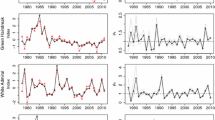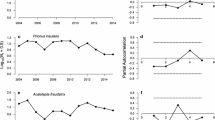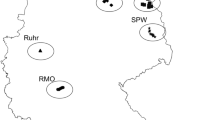Summary
A variety of techniques were used to test for density dependence in 32 time series from bracken-feeding insects. Seventeen taxa (primarily species, but including some pooled data from two or more closely related species whose larvae could not be distinguished in frond surveys) occurred on an open site; a woodland site held 15 taxa. For series of 12 years, collected on the open habitat, direct density dependence was detected by one or more of the techniques in 10 (58.8%) of 17 taxa, compared to only 5 (33.3%) of 15 taxa with time series of 8 years in length from the woodland habitat. Delayed density dependence was detected in 6 cases for the open site and in no cases at the woodland site. Either direct or delayed density dependence was found in 13 (76.5%) of 17 taxa for the open site and 13 (86.7%) of the 15 taxa which occurred on both sites. Although these results suggest a high frequency of density dependence in the species making up the bracken insect community, results from individual tests were extremely variable. Density dependence was detected least often by Vickery and Nudds' (1984) test, and most frequently by Varley and Gradwell's (1960) test, although the latter is prone to high rates of detecting spurious density dependence. Direct density dependence was detected most frequently in taxa that were univoltine and did not have delayed diapause, i.e. in those taxa whose life-histories conform most closely to the assumptions of the models underlying the analyses. Delayed density dependence occurred more frequently in species with more complex life-histories at the open site (taxa that were either bivoltine or multivoltine, or had delayed diapause). The results are consistent with the view that that the bracken herbivore assemblage consists of populations which are independently regulated by density dependent processes, although the present analyses suggest that we cannot rely on these tests to firmly show whether density dependence is present or not in an individual time series of the lengths considered here.
Similar content being viewed by others
References
Andrews RM (1991) Population stability of a tropical lizard. Ecology 72:1204–1217
Bulmer MG (1975) The statistical analysis of density dependence. Biometrics 31:901–911
Gaston KJ, Lawton JH (1987) A test of statistical techniques for detecting density dependence in sequential sequences of animal populations. Oecologia 74:404–410
Gaston KJ, Lawton JH (1988) Patterns in body size, population dynamics and regional distribution of bracken herbivores. Am Nat 132:662–680
Gaston KJ, Lawton JH (1989) Insect herbivores on bracken do not support the core-satellite hypothesis. Am Nat 134:761–777
Hanski I (1990) Density dependence, regulation and variability in animal populations. Phil Trans R Soc London B 330:141–150
Hassell MP, Latto J, May RM (1989) Seeing the wood for the trees: detecting density dependence from existing life-table studies. J Anim Ecol 54:323–334
Heads PA, Lawton JH (1985) Bracken, ants and extrafloral nectaries. II. The effects of ants on the insect herbivores of bracken. J Anim Ecol 53:1015–1031
Heads PA, Lawton JH (1985) Bracken, ants and extrafloral nectaries. III. How insect herbivores avoid predation. Ecol Entomol 10:29–42
Lawton JH (1976) The structure of the arthropod community on bracken. Bot J Linn Soc 73:187–216
Lawton JH (1982) Vacant niches and unsaturated communities: a comparison of bracken herbivores at sites on two continents. J Anim Ecol 51:573–595
Lawton JH (1984a) Non-competitive populations, non-convergent-communities, and vacant niches: the herbivores of bracken. In: Strong DR, Simberloff D, Abele LG, Thistle AB (eds) Ecological communities: Conceptual issues and the evidence. Princeton University Press, Princeton, pp 67–101
Lawton JH (1984b) Herbivore community organisation: general models and specific tests with phytophagous insects. In: Huffaker, CB, Rabb, RL (eds) A new ecology: novel approaches to interactive systems. John Wiley, New York, pp 451–495
Lawton JH, Gaston KJ (1989) Temporal patterns in the herbivorous insects of bracken: a test of community predictability. J Anim Ecol 58:1021–1034
Lawton JH, Heads PA (1984) Bracken, ants and extrafloral nectaries. I. The components of the system. J Anim Ecol 53:995–1014
Lawton JH, MacGarvin M (1986) The organisation of herbivore communities. In: Kikkawa J, Anderson DJ (eds) Community ecology: Pattern and process. Blackwell Scientific Publications, Oxford, pp 163–186
McGarvin M, Lawton JH, Heads PA (1986) The herbivorous insect communities of open and woodland bracken: observations, experiments and habitat manipulations. Oikos 47:135–148
Manly BFJ (1991) Randomization and Monte Carlo methods in Biology. Chapman and Hall, London
Nelder JA, Wedderburn RWM (1972) Generalised linear models. J R Statistical Soc A 135:370–384
Pollard E, Lakhani KH, Rothery P (1987) The detection of density dependence from a series of annual censuses. Ecology 68:2046–2055
Reddingius J (1990) Models for testing: a secondary note. Oecologia 83:50–52
Reddingius J, Den Boer PJ (1989) On the stabilization of animal numbers. Problems of testing. 1. Power estimates and estimation errors. Oecologia 78:1–8
Ricker WE (1954) Stock and recruitment. J Fish Res Board Can 11:559–623
Slade NA (1977) Statistical detection of density dependence from a series of sequential censuses. Ecology 58:1094–1102
Solow AR (1990) Testing for density dependence, a cautionary note. Oecologia 83:47–49
Solow AR, Steele JH (1990) On sample size, statistical power, and the detection of density dependence. J Anim Ecol 59:1073–1076
Southwood TRE (1978) Ecological Methods. 2nd ed, Chapman and Hall, London
Stiling PD (1987) The frequency of density dependence in insect host-parasitoid systems. Ecology 68:844–856
Stiling PD (1988) Density-dependent processes and key factors in insect populations. J Anim Ecol 57:581–593
Strong DR, Lawton JH, Southwood TRE (1984) Insects on plants: Community patterns and mechanisms. Blackwell Scientific Publications, Oxford
Turchin P (1990) Rarity of density dependence or population regulation with lags? Nature 344:660–663
Varley GC, Gradwell GR (1960) Key factors in population studies. J Anim Ecol 29:399–401
Vickery WL (1991) An evaluation of bias in k-factor analysis. Oecologia 85:413–418
Vickery WL, Nudds TD (1984) Detection of density dependent effects in annual duck censuses. Ecology 65:96–104
Vickery WL, Nudds TD (1991) Testing for density-dependent effects in sequential censuses. Oecologia 85:419–423
Woiwod IP, Hanski I (1992) Patterns of density dependence in Moths and Aphids. J Anim Ecol (in press)
Author information
Authors and Affiliations
Rights and permissions
About this article
Cite this article
Holyoak, M., Lawton, J.H. Detection of density dependence from annual censuses of bracken-feeding insects. Oecologia 91, 425–430 (1992). https://doi.org/10.1007/BF00317633
Received:
Accepted:
Issue Date:
DOI: https://doi.org/10.1007/BF00317633




